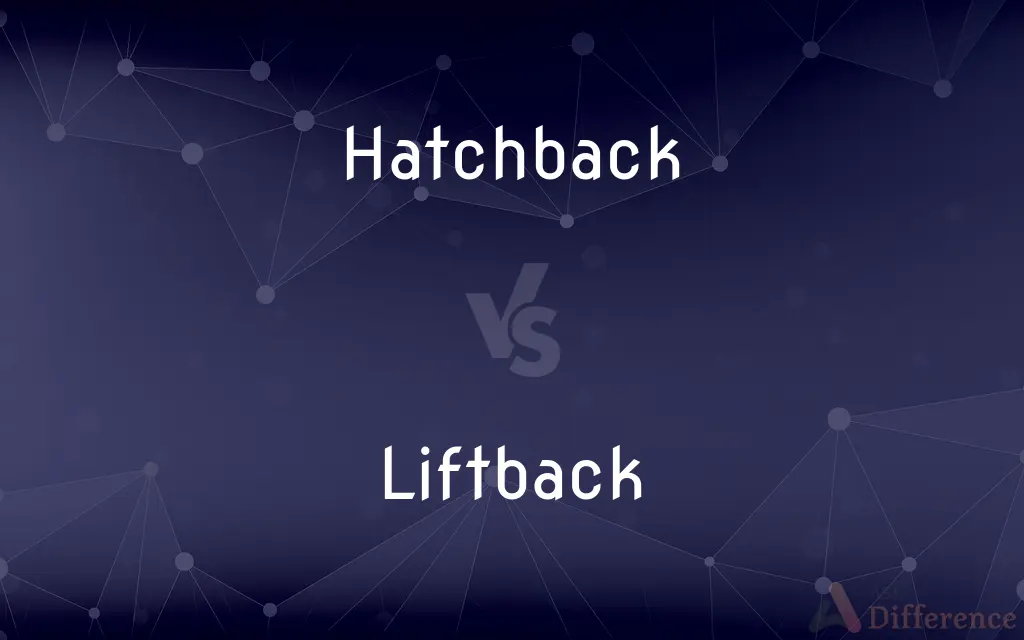Hatchback vs. Liftback — What's the Difference?
By Maham Liaqat & Fiza Rafique — Updated on April 3, 2024
Hatchbacks and liftbacks are both car body styles featuring a rear door that swings upward; however, liftbacks tend to have a sleeker, more sloped rear design compared to the more upright rear of hatchbacks.

Difference Between Hatchback and Liftback
Table of Contents
ADVERTISEMENT
Key Differences
Hatchbacks are characterized by their two-box design, where the rear area for cargo and passengers is accessed through a hatch door. This design typically features a more upright rear end, maximizing interior space and practicality. Hatchbacks can range from small, compact cars to larger models, offering versatility in urban and suburban settings. On the other hand, liftbacks are a subset of hatchbacks with a key distinction in their design. They feature a more sloped rear end, giving them a sportier, coupe-like appearance while still maintaining the functionality of a hatchback. The term "liftback" is often used to describe cars that blend the practicality of hatchbacks with the aesthetics of a sedan or coupe.
While hatchbacks are praised for their practicality, offering ample cargo space and easy access through the rear hatch, liftbacks appeal to those seeking a combination of practicality and style. The sloped rear design of liftbacks often results in a slightly reduced cargo space compared to traditional hatchbacks, but they compensate with a more dynamic and appealing silhouette. This makes liftbacks popular among buyers who desire the look of a sedan but require the utility of a hatchback.
The interior space and comfort of both car types are comparable, with differences mainly in cargo capacity and rear-seat headroom, influenced by the car's exterior design. Hatchbacks might offer more headroom and cargo space due to their boxier shape, whereas liftbacks might compromise slightly on these aspects for a sleeker profile.
In terms of performance, both hatchbacks and liftbacks can vary widely based on the model and manufacturer. However, liftbacks may often be positioned in the market as sportier options, potentially influencing their engineering and performance characteristics to match their dynamic aesthetic.
The choice between a hatchback and a liftback ultimately comes down to individual preferences regarding style, space, and performance. Both offer the practicality of a hatchback door, with the main differences lying in their design, the resulting cargo space, and the overall aesthetic appeal.
ADVERTISEMENT
Comparison Chart
Design
Two-box design with an upright rear end.
Sloped rear end, resembling a coupe.
Practicality
Maximizes interior space for cargo and passengers.
Blends practicality with a sportier look.
Rear Door
Vertical hatch door for cargo access.
Hatch door with a more pronounced slope.
Cargo Space
Generally more due to boxier shape.
Slightly reduced due to sloped design.
Aesthetic Appeal
More functional and utilitarian.
Sportier and more dynamic silhouette.
Compare with Definitions
Hatchback
Known for practicality and space.
She appreciated the hatchback for its ample cargo space.
Liftback
A hatchback variant with a sloped rear design.
The liftback's sleek profile caught everyone's eye.
Hatchback
Upright rear end maximizes interior volume.
The hatchback's upright design offered more headroom.
Liftback
Combines coupe aesthetics with hatchback utility.
He wanted a car that looked like a sedan but had the utility of a liftback.
Hatchback
Versatile and efficient.
Hatchbacks are favored for their fuel efficiency and versatility.
Liftback
May have reduced cargo space due to design.
The liftback traded some cargo space for style.
Hatchback
A car with a two-box design featuring a rear hatch door.
The compact hatchback was perfect for city driving.
Liftback
Appeals to style-conscious buyers.
Style-conscious buyers gravitate towards the liftback for its dynamic appearance.
Hatchback
Popular among urban drivers.
Urban dwellers often choose hatchbacks for their compact size.
Liftback
Sportier appearance.
The liftback model appealed to her with its sporty look.
Hatchback
A hatchback is a car body configuration with a rear door that swings upward to provide access to a cargo area. Hatchbacks may feature fold-down second row seating, where the interior can be reconfigured to prioritize passenger or cargo volume.
Liftback
A liftback is a variation of hatchback with a sloping roofline between 45 to 5 degrees. On the contrary, traditional hatchback designs usually has a 90 to 46 degree slope on the tailgate or rear door.
Hatchback
A rear door on certain automobiles that opens upward.
Liftback
(US) hatchback
Hatchback
A compact automobile having such a door.
Hatchback
A car with a sloping, hinged rear door that opens upwards.
Hatchback
The door itself.
Hatchback
A car having a hatchback door
Hatchback
A sloping rear car door that is lifted to open
Common Curiosities
What is a hatchback?
A hatchback is a car design characterized by a two-box configuration and a rear hatch door, offering practicality and ample interior space.
Can liftbacks perform as well as hatchbacks?
Performance varies by model and make, but liftbacks often target a sportier market segment, which can influence their performance characteristics.
Are liftbacks less practical than hatchbacks?
While liftbacks may offer slightly less cargo space due to their design, they still provide considerable practicality alongside a more appealing aesthetic.
How does a liftback differ from a traditional hatchback?
A liftback features a more sloped rear end, giving it a sportier appearance compared to the more upright rear of traditional hatchbacks.
Why would someone choose a hatchback over a liftback?
Someone might prefer a hatchback for its maximal interior space, practicality, and potentially lower cost compared to the more style-oriented liftback.
Do liftbacks cost more than hatchbacks?
Liftbacks can sometimes cost more due to their sportier design and potentially higher-end market positioning, but prices vary widely across different models.
Can the rear seats in hatchbacks and liftbacks be folded down?
Yes, both designs typically allow for rear seats to be folded down to increase cargo space.
Is a liftback the same as a sedan?
No, a liftback resembles a sedan in appearance but features a hatchback-style rear door, offering more cargo space and practicality.
What are the best scenarios to use a hatchback?
Hatchbacks are ideal for city driving, small families, and individuals needing a versatile and efficient vehicle for daily use and occasional cargo needs.
Are hatchbacks and liftbacks good for long drives?
Both are suitable for long drives, with comfort levels and fuel efficiency varying by model. Their spacious interiors make them practical for road trips.
Who typically buys liftbacks?
Liftbacks attract buyers looking for a blend of stylish design, the practicality of a hatchback, and a sportier driving experience.
Can you get sporty hatchbacks?
Yes, there are sporty hatchback models designed with performance in mind, offering a good balance between practicality and dynamic driving experiences.
What are the environmental impacts of choosing a hatchback or liftback?
The environmental impact depends on the vehicle's fuel efficiency and emissions. Both styles can be environmentally friendly, especially models with hybrid or electric powertrains.
How does cargo space in a liftback compare to a sedan?
Liftbacks generally offer more cargo space and flexibility than sedans due to their hatchback-style rear door, despite their similar profiles.
How important is the design of a car's rear in choosing between a hatchback and liftback?
The design significantly influences choice, with preferences for more cargo space and headroom leaning towards hatchbacks, and preferences for style and aesthetics leaning towards liftbacks.
Share Your Discovery

Previous Comparison
Scroll vs. Roll
Next Comparison
Chore vs. LineAuthor Spotlight
Written by
Maham LiaqatCo-written by
Fiza RafiqueFiza Rafique is a skilled content writer at AskDifference.com, where she meticulously refines and enhances written pieces. Drawing from her vast editorial expertise, Fiza ensures clarity, accuracy, and precision in every article. Passionate about language, she continually seeks to elevate the quality of content for readers worldwide.














































